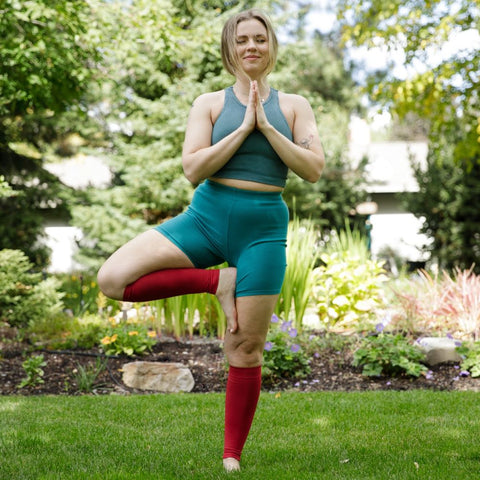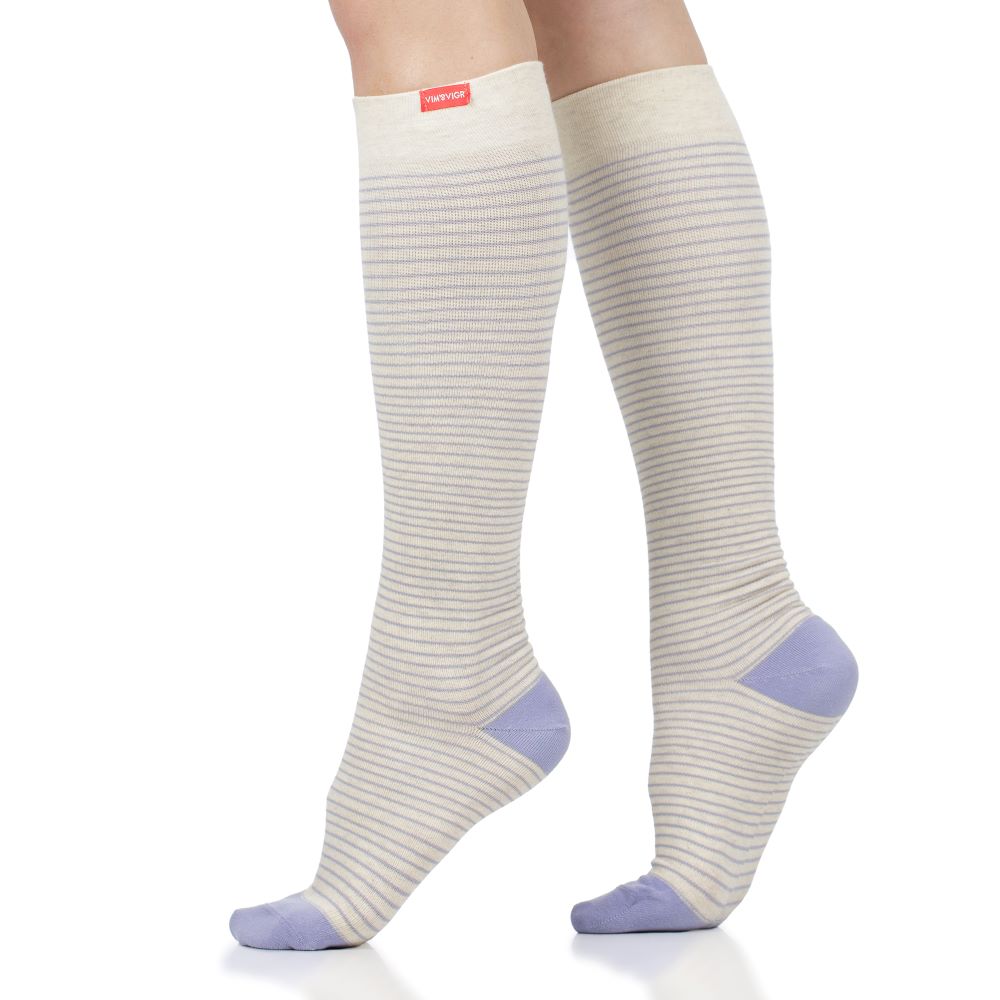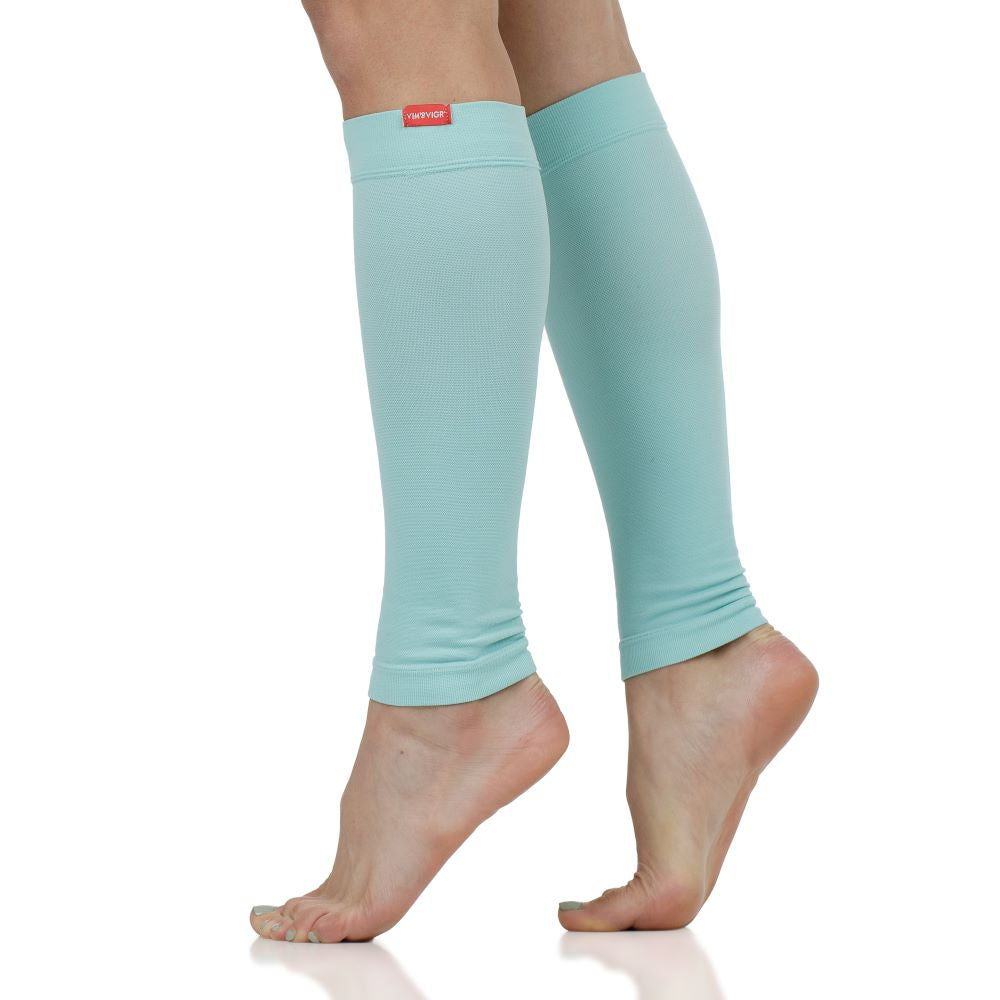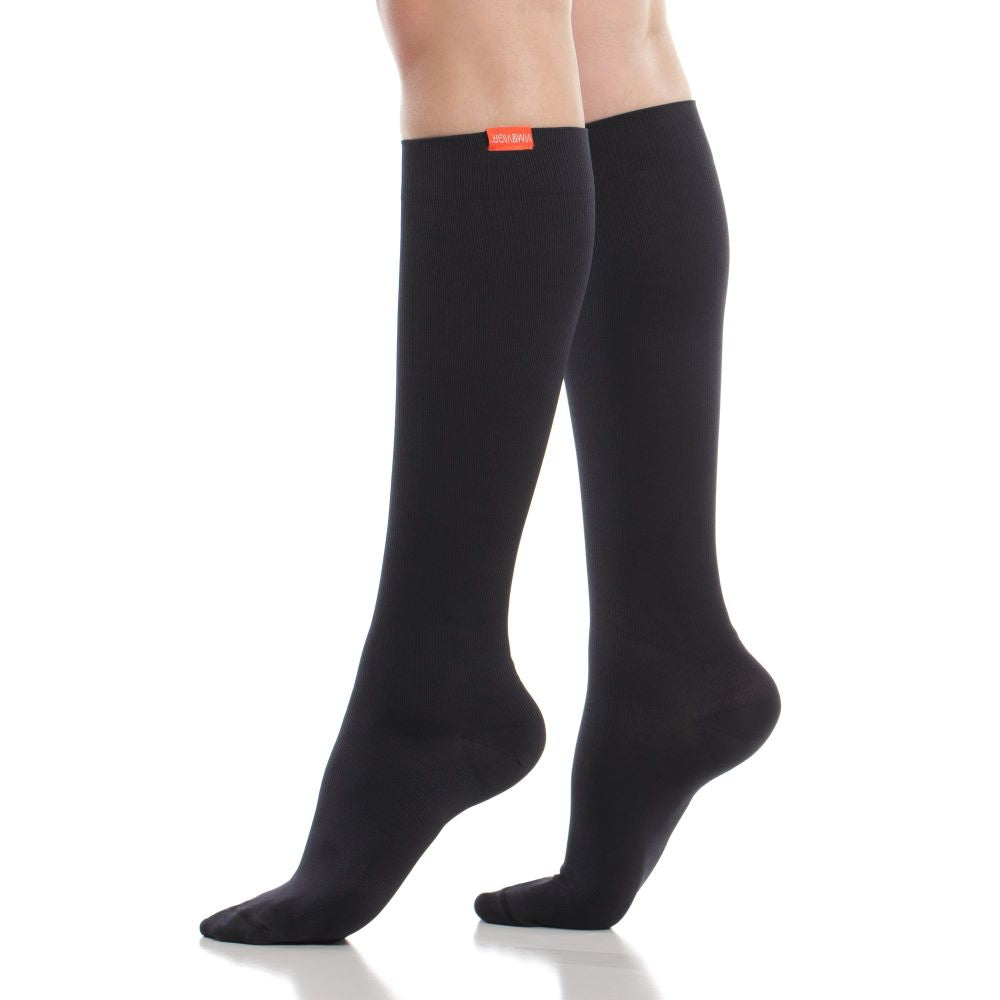The Benefits of Compression for Lipedema & How It Works
Compression socks and stockings are the best friends of athletes, active hikers, nurses, teachers, and many frequent travelers. But they’re not only a great help for everyday physical activity and symptoms of heavy legs. If you suffer from chronic illness or medical conditions that affect blood flow, they can be a lifesaver and improve your quality of life.
How do compression socks help when you have lipedema? Thanks to graduated pressure applied from the bottom of your lower legs and decreasing towards the knees, compression socks and stockings support blood flow back towards the heart. This helps reduce swelling and pain and enhances lymphatic flow. It also helps contour and shape the lower legs.
Read on to find out all you need to know about lipedema, the use of compression therapy, and how to pick the best socks for you.

Understanding Lipedema
Firstly, let’s take a look at what lipedema is and how it can affect your everyday life. Caused by abnormal fat buildup on the lower body, lipedema usually refers to excessive fat in the legs. This can make you feel pain and make any activity more difficult.
Unfortunately, lipedema isn’t simply “ordinary” fat. It cannot be fought with diet and exercise, as would be the case with simply being overweight. It is also not a curable condition. Rather, lipedema symptoms can be treated with a range of approaches that include:
- Low-impact exercise like swimming, biking, and walking. These will help increase your mobility and reduce swelling in the legs;
- Anti-inflammatory and heart-healthy diets, which can help slow down its progression and improve your overall well-being;
- Compression therapy to address swelling and pain;
- Medications and supplements as directed by your doctor;
- Lymphatic drainage massage to relax the lower extremities and fight swelling;
- Etc.
Lipedema can first be identified through the aspect of your skin. Although looking normal, many patients report feeling like they have “pebbles” under the skin. This may be accompanied by pain and bruising.
As it evolves, the stages of lipedema look like this:
- Skin surface becomes uneven and may present dimples (like quilted stitching, walnut shells or cottage cheese);
- Legs will become swollen, looking like inflated rectangular balloons. You may have large folds of skin and fat. At this point, the fat in the legs sticks out and makes it difficult to walk;
- In Stage 4, lipedema is enhanced by lymphedema - you can suffer from both at the same time.
How Compression Therapy Works for Lipedema
In all cases of lipedema, one of the key symptoms is swelling in the legs, doubled up by pain and discomfort. Compression therapy reduces pains and aches in the lower extremities, while bringing down inflammation and swelling.
Wearing compression garments stimulates the blood flow in a particular part of the body. Graduated compression socks are tighter towards the feet and slowly decrease in pressure towards the knee, helping “push” blood and fluid towards the heart. This makes the circulatory system work at its best and reduces the risk of swelling and inflammation.

Additionally, wearing compression socks, stockings, and tights can help with lipedema symptoms like pain, fat sticking out, and mobility issues. Through the tight hold on your muscles, compression garments give you extra stability and support. They also help prevent skin flaps rubbing or moving, improving your mobility and making movement more pleasant.
The Benefits of Compression for Lipedema
Although lipedema cannot be cured or reversed, there are a few ways in which you can improve your well-being if you suffer from this type of medical condition. Classic symptoms of lipedema, like swelling and pain in the legs, can be addressed quite effectively by wearing compression socks. Here are some of their benefits.
Reduction of Edema and Swelling
Helping blood and fluid move more efficiently in the body and directing it back towards the heart is one of the main benefits of wearing compression socks for anyone. When the circulatory system performs well and there are no fluid build-ups in the lower limbs, you’re less likely to suffer from swelling or edema.
Reduce the feeling of heavy legs by wearing compression socks as directed by a health professional. With regular wear, you should see less swelling and feel lighter and more energetic.
Reduced Pain and Improved Mobility
Thanks to their tight hold on the lower extremities, compression socks play a positive role in improving the mobility of lipedema patients. Excess skin and fat can be better held in tighter garments. This means there’ll be less rubbing, reducing the likelihood of pain and chafing. As a result, going for a walk or doing some light exercise will feel more fun and comfortable.
Enhanced Lymphatic Flow
Studies have found that compression socks help circulate lymph back into the venous system, reducing the risk of lymphedema and making lipedema patients feel more comfortable.
Compression wear is often prescribed by doctors to assist lymph circulation along with blood flow. They will reduce swelling throughout the legs and can even prevent fat disorders like lipedema from progressing.

Improved Circulation
Blood flow is essential for the good functioning of our entire body. Through the circulatory system, our muscles receive oxygen and nutrients, while we repair and re-energize after efforts. For lipedema patients, improving circulation ensures there is no additional swelling in the legs from blood pooling in the lower half of the body. Compression therapy supports this, stimulating blood flow and ensuring that you are as comfortable as possible.
Contouring and Shaping
As compression socks hold your lower legs tight, they contribute to a better shaping of the lipedema affected area. They can be used to hold in the excess fat and skin flaps, so that you’re less likely to hurt or chafe when walking. Ultimately, this also helps contour your silhouette and you can style your compression garments with a multitude of outfits to look and feel your best.
Choosing Compression Garments for Lipedema Relief
To ensure you get the full benefit of wearing lipedema compression socks, you need to pick a pair that offers the right levels of pressure and that fits and behaves right. Here are our tips for making a choice.
Compression Level
Compression level refers to how tight the socks will feel. For beginners, you should start with the least pressure, gradually increasing if needed, unless your doctor recommends otherwise. Here are the most common compression levels:
- Moderate (15-20 mmHg) - everyday casual socks, that you can wear in any setting and without any medical prescription. This is lightweight compression but still strong enough that you’ll feel a tight hold on your legs and a gentle massage;
- Moderate to firm (20-30 mmHg) - firmer compression that’s usually referred to as medical grade. This is the level usually recommended for edema patients, so you may want to consult with your healthcare provider if you think this level is the best for you;
- Firm (30-40 mmHg) - prescription-only, very tight compression socks. These are commonly used to treat conditions like lymphedema and could be great for lipedema patients as long as your doctor agrees.
Type and Style
When it comes to compression garments, there are actually many types of clothing that you can use on the lower body: stockings, tights, leggings, calf sleeves, ankle socks… and the list goes on.
For lipedema, you’ll be best served by garments that cover as much as possible of your lower legs. This means compression socks (which go up to just below the knee) and stockings, leggings, and tights (covering the full length of your legs). Calf sleeves can also be appropriate for focusing on the calf muscle area only.
The key thing is to pick compression garments that you’ll enjoy wearing, as that means you’re more likely to use them regularly and enjoy their benefits.
Size and Fit
Good fit is key for compression therapy. After all, if items don’t feel tight enough, you won’t really get any benefit. However, go too tight and all you’ll be left with is bad circulation and possibly bruises and discomfort.
To make sure your compression socks fit well, use a sizing guide and measure the circumference of your calf. Then, refer to our guides on how to put on and take off compression socks to ensure you’re wearing them properly without injuring yourself.
Material
Finally, it’s important to pick the right fabric for your activity levels, weather conditions, and general comfort. Compression socks usually come in the following:
- Cotton - great for everyday wear and can be styled with pretty much any outfit and in any environment; however, it doesn’t wick moisture well in really humid or hot conditions;
- Nylon - tighter, thinner socks that fit really close to the body and move with you; ideal for exercising in, moisture wicking, and flexible;
- Merino wool - great in any weather conditions thanks to their incredible moisture wicking and breathability properties; they’ll keep your feet dry and cool in summer, but warm and cozy in winter.
There are other combinations of fabrics, such as moisture-wicking Nylon enhanced to ensure your feet don’t get sweaty. Make sure to read the care instructions, too, to prolong the life of your socks.
How Long to Wear Compression Garments for Lipedema
Depending on your situation, you can wear compression garments for lipedema for as long as you feel comfortable. Moderate compression socks are usually suitable for all-day wear. However, if you prefer, you can also wear compression garments at night.

Your doctor can advise on other types of compression garments and devices, as well. For example, some patients may benefit from using pneumatic compression devices in a clinic on a regular basis. Others could be using compression boots at home. These options can be used in parallel to compression socks when treating the symptoms of lipedema.
Lifestyle Practices to Complement Compression Therapy
Beyond compression therapy, there are a few more things you can do to make life easier and more comfortable when you have lipedema. Here are some of our tips.
Healthy Diet
Eating a diet that’s low in salt can help reduce the likelihood of water retention and swelling in the legs. You can also benefit from an anti-inflammatory diet, which will reduce pain and discomfort in the legs.
Generally, a healthy diet put together with the help of a medical professional will not reverse lipedema, but can help improve your quality of life significantly.
Exercise
Movement can be painful for lipedema patients, but there’s still exercise you can do to stimulate blood flow and prevent the advancement of lipedema. Swimming and biking are low-impact sports that you can engage in. Most gyms or pools also offer in-water exercise classes like aqua aerobics, which take the weight off your legs and feel really nice in the water - give those a try!
As for walking, light strolls are great for getting the legs moving. Wearing your compression socks when you’re out walking will support your lower legs and make you feel more comfortable when you move, too.
Emotional Health and Seeking Support
Any serious medical condition has an impact on your emotional health and well-being. Don’t shy away from discussing this with your doctor and talking about how your diagnosis and effects on everyday life are affecting your mental health. There are support groups and resources, online and in person, that you can access with their guidance.
Finally, remember to reach out to your friends and family and be honest about your condition and how it affects you. You can organize some group activities to get more motivated to swim or walk, for example, and you can get immense benefits from simply talking and being listened to.



















Thank you so much for this article it was very informative I learned more about my condition that what the doctor explained the dos and don’ts. I was sent home with a compression socks prescription and I lo see you in 6 months. Now I am a lot clearer. Thanks
Leave a comment